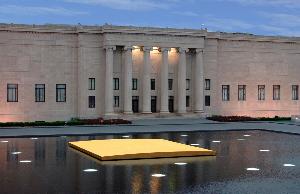Walter Joseph De Maria
Walter Joseph De Maria;Walter De Maria
Place: New York City
Born: 1935
Death: 2013
Biography:
Walter Joseph De Maria was an American artist, sculptor, illustrator, and composer who lived and worked in New York City. Born on October 1, 1935, in Albany, California, De Maria's artistic practice is connected with minimal art, conceptual art, and land art of the 1960s.
Early Life and Career
De Maria studied history and art at the University of California, Berkeley from 1953 to 1959. Trained as a painter, he soon turned to sculpture and began using other media. In 1960, De Maria moved to New York City where he married his wife Susanne Wilson (later Susanna) one year later. His early sculptures from the 1960s were influenced by Dada, suprematism, and constructivism. Walter Joseph De Maria is known for his innovative approach to art, which led him to use simple geometric shapes and industrially manufactured materials such as stainless steel and aluminum – materials that are also characteristic of Minimal art. With the support of collector Ethel Scull, De Maria started making pieces in metal in 1965.
Notable Works
Some of his notable works include Boxes for Meaningless Work, which is inscribed with the instructions, "Transfer things from one box to the next box back and forth, back and forth, etc. Be aware that what you are doing is meaningless." This piece is a great example of De Maria's task-oriented, game-like projects that resulted in viewer-interactive sculptures. De Maria also produced Minimalist sculptures such as Three Circles and Two Lines in the Desert, which was included in the seminal 1966 Primary Structures exhibit at the Jewish Museum in New York. He appeared in happenings, composed two musical works (Cricket Music, 1964; Ocean Music, 1968), and produced two films (Hardcore, 1969).
Later Life and Death
In 1980, De Maria bought a four-story, 16,400-square-foot Con Edison substation at 421 East Sixth Street, and an adjacent lot at No. 419, between First Avenue and Avenue A. In February 2014, this property was selling for $25 million. Businessman and art collector Peter Brant purchased De Maria's studio for $27 million. De Maria went to California in May 2013 to celebrate his mother's 100th birthday and had a stroke there a few days later. He remained there for treatment and died in Los Angeles on July 25, 2013, at the age of 77.
- Visit https://Wikioo.org/@/Walter-Joseph-De-Maria to learn more about Walter Joseph De Maria's life and work.
- Check out https://Wikioo.org/Art.nsf/Art_EN?Open&Query=walter+joseph+de+maria,de+maria,joseph,maria& for a collection of his notable works.
is considered one of the greatest artists of our time by LACMA director Michael Govan. His innovative approach to art and his use of simple geometric shapes and industrially manufactured materials have made him a pioneer in the Minimal art movement.

